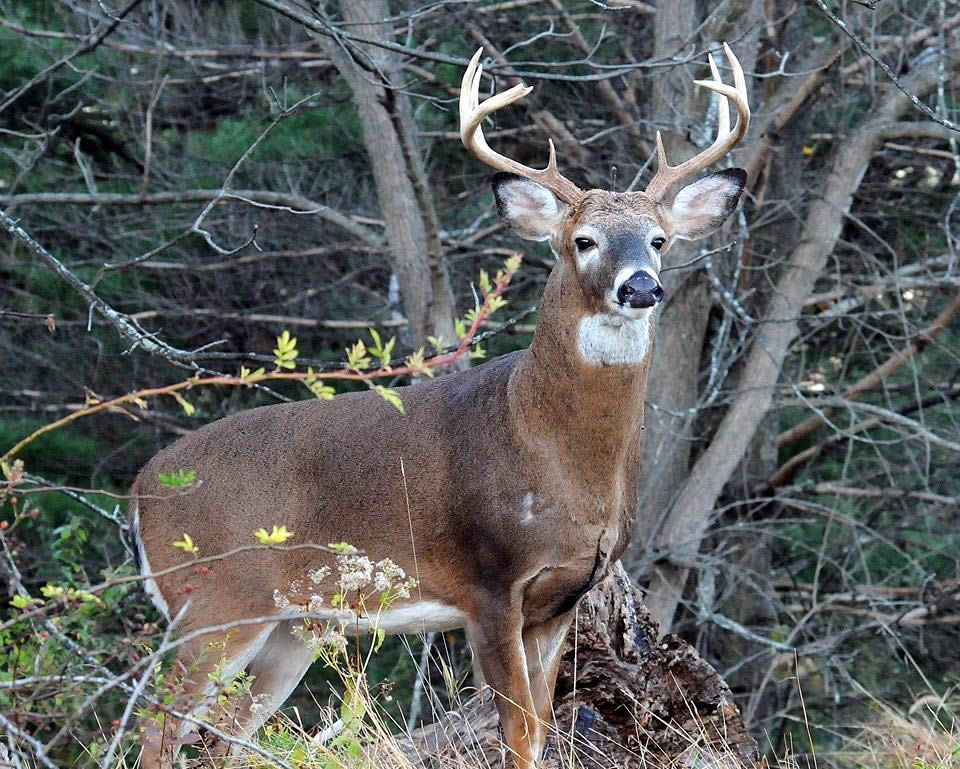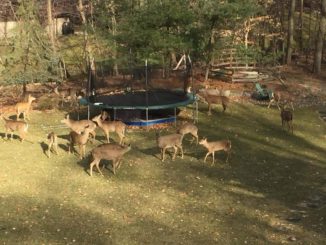
RIVER VALE, N.J.—Local officials will consider non-lethal options for deer management Nov. 26 when representatives from the Animal Protection League of New Jersey appear before the Township Council to discuss strategies—and surgical options—to reduce the township’s’s increasing deer population.
Previously, the Township Council scheduled a Dec. 10 workshop meeting with state Division of Fish and Wildlife officials to discuss state-approved deer control options. Both meetings are workshop meetings, generally not open to public comment, although council members can agree to open a meeting for comment if a majority agrees.
“The facts here are simple. They’re both going to be allowed air time to explain how we can best solve our deer overpopulation problem,” said Business Administrator Gennaro Rotella Nov. 9, noting the Nov. 26 presentation on non-lethal options.
Rotella said the council wants to hear management options from both sides and “ask the tough questions” on pros and cons of lethal and non-lethal approaches.
After initially advocating the “likely need” for a bowhunt to reduce a deer population boom that has led to increased auto accidents, River Vale Mayor Glen Jasionowski said he was willing to hear all points of view from advocates of lethal and non-lethal methods.
Jasionowski said Oct. 22 that after the council hears from both groups, it will discuss and decide what option may best work for River Vale.
Although River Vale has grabbed much attention lately by focusing on a solution to its deer population problem, other area towns have faced increasing challenges from deer, although most have declined to take action or undertake a control strategy.
While declining to address the problem, some have reported an anecdotal increase in car accidents, human-deer conflicts, and local deforestation caused by deer browsing native and landscape plants.
Montvale listens
Doris Lin, director of legal and government affairs for Animal Protection League of New Jersey, appeared Nov. 1 at Montvale’s town hall meeting and provided an overview of non-lethal options.
Lin said in 2016 and 2017, state hunters killed more than 49,000 deer—half of the state’s deer population—but that the population “did not go down…due to increased deer fertility” that occurs after deer populations are reduced by hunting.
Lin explained that to get a permit for a non-lethal deer control program requires a permit from the state Division of Fish and Wildlife. However, she said, the state only recognizes two non-lethal deer control options: trap and transfer and chemical sterilization.
One method that the Animal Protection League recommends is surgical sterilization, which involves removing female deer ovaries, called ovariectomies, which prevents the does from bearing offspring.
“There’s absolutely no mention of surgical sterilization in their [Fish and Wildlife Community-Based Deer Management Program] handbook. That’s how heavy their bias is in favor of hunting,” Lin told the Montvale audience. She said each surgery costs $1,000 to $1,200.
One point of contention between Lin and Fish and Wildlife is that agency officials do not consider surgical sterilization an effective option for fertility control.
Previously she has urged Pascack Valley mayors—during an Oct. 9 presentation to the county’s League of Municipalities at Arena Diner in Hackensack—to lobby state officials in hopes of getting surgical sterilization of female deer approved as another non-lethal option by the state.
[slideshow_deploy id=’899′]
State rejects sterilization
Lin notes that state wildlife officials rejected a plan proposed in May by Saddle River that used surgical sterilization for two reasons, both of which she disagrees with.
In rejecting surgical sterilization, the state sai Saddle River’s proposed plan cannot be both a plan to reduce population and an experiment to determine population impacts and that other states’ fertility research projects show “low expectations of successfully reducing deer in an open population or reducing human-deer conflicts in a timely or cost-efficient manner.”
After its rejection, Saddle River implemented a contract with United Bowhunters of New Jersey for a controlled bowhunt that was ongoing at press time.
‘At some point…’
“At some point we have to consider a solution,” said Mayor Michael Ghassali, following Lin’s presentation Nov. 1 on non-lethal options.
Ghassali said he was not in favor of lethal options, preferring control and non-lethal strategies.
Ghassali said he had called the Saddle River police, who told him that 40 deer had been killed by its bowhunt so far this year.
“But as you saw there is a cost [for non-lethal options] so we’ll have to come back to the council at some point and we have to budget for that solution, and that’s you paying for it,” Ghassali told some 40 residents attending the meeting.
Resident Carolee Adams suggested a countywide regional deer control strategy may be best and that other funds may be available to pay for non-lethal deer control options.
Lin told her that “you need multiple towns on board” and not just the county to propose a regional non-lethal deer control strategy.
Englewood’s deer
Even relatively urban areas such as Englewood often encounter deer near the city’s downtown and surrounding streets much more than they did five to 10 years ago, according to officials.
During a one-night survey early this year, 40 deer were spotted in an approximately five-square mile area of Englewood by volunteers of the city’s new Deer Task Force—almost double the amount spotted eight years ago.
“You were seeing over double the amount of deer in our city… spread across all the wards,” said Ward II Councilman Michael Cohen in January, who suggested more deer are responsible for vehicle accidents, injuries and spread of Lyme disease.
Cohen noted the deer task force would be making recommendations for council action. No measures were proposed.
Cohen said Nov. 13 the city Health Department was holding a meeting on deer management Dec. 6, 7:30 to 9:30 p.m., at Englewood Hospital featuring wildlife biologists from Division of Fish and Wildlife and Englewood was inviting officials from nearby towns.
According to a flyer distributed by the city, the session deals with deer impacts on forest health, deer-human interactions, including deer-vehicle accidents and damage to ornamental plantings and tick-borne disease.
For more information, call the Englewood Health Department at (201) 568-3450.
[slideshow_deploy id=’899′]


